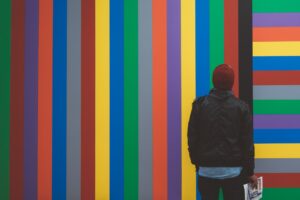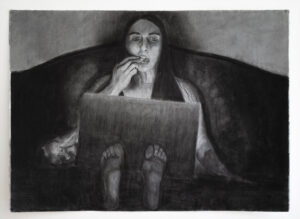Process Drawing for Families with Becky Jane Rosen
Description
Process drawing emphasizes the process of creating rather than the end product. As shown in the work of Sol LeWitt, one of the leading proponents of process drawings, the works often involve repetition of shapes and outlines, creating intricate and mesmerizing images from simple forms. In this workshop, participants created process drawings in response to COVID-19 (e.g., choosing an object used often during the pandemic, like a mask or bottle of hand sanitizer, and then tracing this object multiple times and color the shapes created).

Instructor Bio
Becky Jane Rosen (she/her) is an artist and art educator based in Portland, Maine. She graduated from Bowdoin College, where she was awarded the Kaempfer Grant and Richard J. Martel Memorial Prize. She received an MAT in Art Education from Tufts University and an MFA in Painting from CUNY Hunter College. Rosen has worked as an art educator at the Museum of Fine Arts, Boston, at public schools in Massachusetts and New York City, and at CUNY Hunter College.

Artist’s Statement
As an artist and art educator, I think it’s important to remember that even in times of great stress and suffering, we can still make art. You can be creative and make art anywhere, no matter the circumstances. The wonderful thing about process drawing is that it is very flexible, and lends itself to people of all ages and to materials they already have. Process drawing allows you to create a small world that you can control, in a world where you may feel like you don’t have control.
Workshop Results
This essay is by workshop instructor Becky Jane Rosen.
Families with school-age children saw great shifts in their children’s education in 2020. Parents likely participated more actively in their children’s education than when their children were in a school building. My goal in offering the process drawing webinar for families was to give parents and children the opportunity to do a guided project side-by-side together rather than another assignment where parents direct their children to stay on task, as can often happen in the new ever-evolving world of virtual education.
With process drawing, a set of instructions drives the creative act rather than the artist having a preconceived notion of what the end product will look like. The artist may interpret those instructions any way they like, which makes for fun and increasingly varied responses. Process drawing works well for families because the instructions can be interpreted by people of all ages, and no drawing experience is necessary. Every response is equally valid, no matter the artist’s skill level.
For this webinar, the artist’s instructions were: “Find a small, traceable object you use often or look at differently due to the pandemic. Trace your object at least 2 times. Each tracing should overlap with at least one other tracing. Now, color in the shapes you’ve created. Remember that your overlapping created lots of new shapes!” Participants really enjoyed the webinar and process. My most memorable moments as an instructor came when artists shared their work with the group, talked about how they made their drawings, and what objects they chose to trace and why. It was so interesting to hear about other families’ pandemic experiences, such as cooking more at home and doing puzzles together. We could also collectively enjoy a laugh over how we all look at toilet paper differently now!
As an artist and art educator, I believe it’s extremely important to remember that even in times of great stress and suffering, we can still make art. Creating process drawings with materials you already have allows you to create a small world that you can control in a world where you may feel like you don’t have control. You can be creative and make art anywhere, no matter the circumstances.
